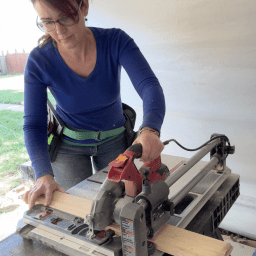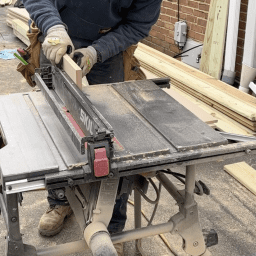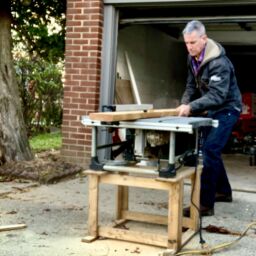Yes, a Skil recip saw. We tested the Skil PWRCORE 20 recip saw in our remodeling and deck building work. Here’s what you should know before you decide if the Skil reciprocating saw is right for you.
Get the Skil PWRCORE 20 recip saw at Amazon.
A Skil reciprocating saw? Anybody who’s been around tools for a chunk of time can assure you that Skil used to be a junk drawer brand. They were designed for occasional use like fixing a deck board or hanging art or blinds. Low yield, low power. Along with Black & Decker in those days, they were the Corn Flakes or Graham Cracker of tools.
Those days are over.
Everything I’ve tried in the new Skil trade dress has been an exceptional unit, everything from their torpedo-ish-shaped little Skil drill/driver to their pro-grade oscillating tool to what I think is–for the work we do–the best table saw in the industry.
This includes the Skil 20V 2.0 amp-hour cordless brushless reciprocating saw. Let’s get into how we tested the Skil recip saw.
The Skil Recip Saw Test
Here’s how we tested the Skil reciprocating saw. The battery taken alone puts this saw solely in the DIY category. 20 volts is good power (think of volts as octane; higher octane means more output). But 2.0-amp-hours (think of amp-hours as the size of the gas tank) is a pretty small tank.
However, I’ve had the saw on my truck for some time now and–-because I have other Skil tools–-I’ve gotten what batteries come with what tool all jumbled up so I just run the thing. The two main projects I used the tool on was demolishing a shed and dismantling an outgrown playset.
Between these projects and the various fence posts and deck posts and whatever else I’ve used the unit for, it’s got pro-grade potential. It depends on the pro, but we’re way beyond the junk drawer and pegboard in the garage.
Fit & Finish.
You can usually tell a low price-point tool. It’s awkward and off balance. The switches suck and are hard to reach. Blade changes almost hurt. Start and stop are abrupt. None of that is the case with the Skil reciprocating saw unit. It feels solid and it works solid.
Power.
This is an odd one. And it’s not even a complaint. The Skil recip saw delivers ample juice. I didn’t notice any hiccup whatsoever until I was dismantling the playset.
Unlike the shed demo project where pieces fell easily away, the playset had pinch points as the parts kind of twisted as I cut them loose. It was in these pinch points that the blade stopped and I needed to clear it it from the work to start it again. It’s not that the tool lacked power. It was not “allowed” to work when obstructed. I don’t know and I’m not going to ask Skil, but this seems like electronic feedback control that won’t let the tool operate if it senses stress on the blade. This is an issue for full-tilt-boogie pro work for sure.
The sister brand to Skil is Flex and I use those tools all the time. The Flex 6 1/2-inch circ saw–this saw is outstanding–has the same electronics. If just a bit of tooth is on the work, it won’t spin up.
Battery(ies).
Skil has a fast-charging feature I would have used in the playset demo for darn sure if I only had one battery–very common in DIY, I’m sure. Taking that thing down took two-ish charges; I have no idea how many bars I started with on battery #1, so that’s a rough estimate.
It’s called PWRJump and it zips the battery back up to 25% power in 5 minutes. I have no way of testing this, but I also have little reason to doubt it because the tool works so well on so many other levels.
Features.
It has straight recip and orbital action. The Skil recip saw’s blade holder is tool-less. These aren’t really features, but they do work. It also might be worth pointing out for tool dweebs that tool manufacturers buy parts from 3rd parties. I think almost every recip saw has the same twist-release blade holder and they all suck when they get full of drywall dust.
Get the Skil PWRCORE 20 recip saw at Amazon.
High Marks for the Skil Recip Saw
The Skil reciprocating saw delivers like every other Skil tool I’ve used–other than the table saw which is a rare find that blows all other doors off: It does what I need done in a professional application and delivers the results we need to deliver to our clients.
How many High Marks does this DIY-designed tool get?
Pro.
2 to 4 High Marks. For remodeling pros like me, the Skil reciprocating saw works. For contractors running hard core demo. you should probably just go old school and plug in anyway.
DIY.
5 High Marks. DIYers won’t be doing remodeling demo, necessarily. But a good recip saw is a great homeowner tool. Everything from downed tree branches and dead saplings (the Diablo carbide-tipped, deep gullet blade is perfect for this Skil recip saw. Cut down old shelves, break apart old cabinets the geezer you bought your house from left behind.
A reciprocating saw is a tool you’ll use. To round it out, here’s a reciprocating saw tip.







